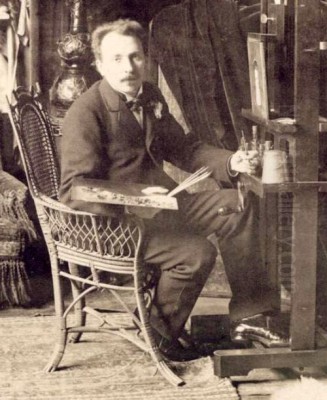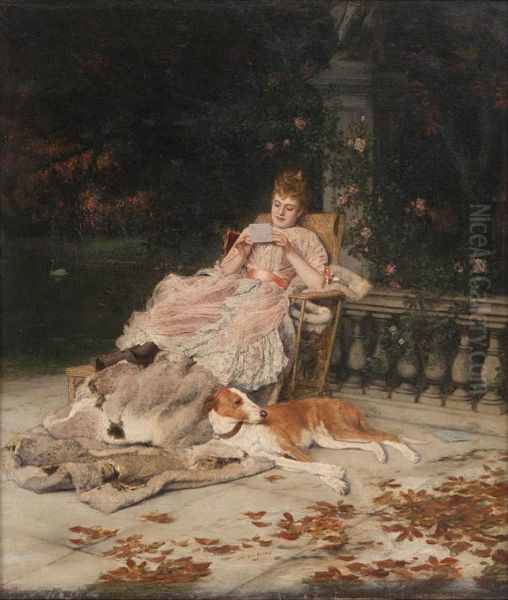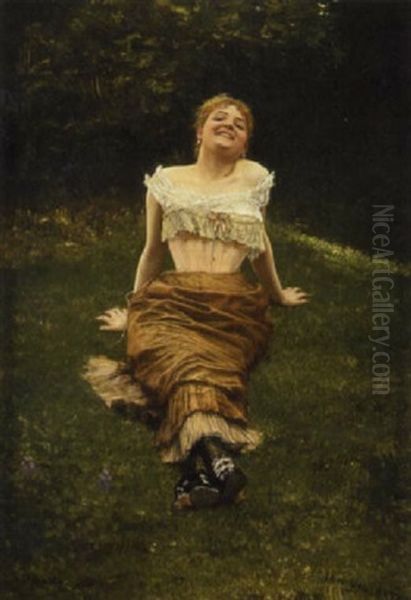Introduction: A Belgian Talent in Paris

Jan van Beers, born Jean Marie Constantin van Beers on March 27, 1852, in Lier, Belgium, was a distinctive figure in the European art scene of the late nineteenth and early twentieth centuries. He passed away in Fay-aux-Loges, France, on November 17, 1927. Primarily known as a painter and illustrator, Van Beers carved out a significant reputation, especially within the vibrant artistic milieu of Paris during the Belle Époque. Though beginning his career exploring historical themes, he became celebrated for his genre scenes and, most notably, his exquisitely detailed small-scale portraits, often depicting elegant women. His journey from the academies of Belgium to the salons of Paris charts a fascinating course through the changing artistic landscape of his time.
It is important to distinguish the painter Jan van Beers (1852-1927) from his father, the renowned Flemish poet Jan van Beers (1821-1888). The painter is sometimes referred to as Jan van Beers the Younger to avoid confusion. Furthermore, the painter himself had a son, also named Jan van Beers, who pursued a career in art, adding another layer to the family's artistic lineage. This article focuses specifically on the life and work of the painter Jan van Beers, son of the poet.
Early Life and Artistic Formation in Antwerp
Jan van Beers received his formal art training at the prestigious Royal Academy of Fine Arts in Antwerp. This institution was a crucible for artistic talent in Belgium, nurturing many painters who would go on to achieve national and international recognition. During his time at the Academy, Van Beers demonstrated considerable promise and a charismatic personality that drew others to him.

He became the central figure of a group of ambitious young artists often referred to as the "Van Beers clique." This circle included fellow students such as Alexander Struys and Jef Lambeaux. Known for their somewhat eccentric and flamboyant behaviour, they reportedly enjoyed parading through the streets of Antwerp dressed in historical costumes, signalling a youthful rebellion against convention and perhaps an early immersion in the historical themes that would initially characterize Van Beers's work. Their antics suggested a desire to live and breathe art, blurring the lines between historical fantasy and contemporary life.
Despite the camaraderie and shared experiences at the Academy, Van Beers, along with Struys and Lambeaux, eventually decided to leave the institution before completing their studies. They sought to establish themselves as independent artists, eager to make their mark on the art world on their own terms. This departure marked a crucial step towards Van Beers developing his individual artistic voice, moving beyond academic constraints. Alexander Struys, in particular, remained a close friend, and Van Beers later persuaded him to join his studio in Antwerp for a time, highlighting their continued artistic bond.
The Move to Paris and a Shift in Style
In 1878, seeking broader horizons and greater opportunities, Jan van Beers made the pivotal decision to move to Paris. The French capital was undeniably the epicentre of the Western art world at the time, attracting artists from across Europe and beyond. This move proved instrumental in shaping the direction of his mature career. In Paris, he found himself immersed in a dynamic environment brimming with new ideas, influential figures, and discerning patrons.
Soon after arriving, Van Beers began working in the studio of Alfred Stevens, another highly successful Belgian painter who had already established a formidable reputation in Paris. Stevens was known for his elegant depictions of fashionable contemporary women and scenes of modern life, executed with refined technique. Working alongside Stevens likely exposed Van Beers to the demands of the Parisian art market and reinforced the appeal of contemporary subject matter over purely historical scenes. Stevens himself was a significant figure, bridging academic precision with an interest in modern themes, influencing artists interested in depicting the nuances of Belle Époque society.
This period marked a distinct transition in Van Beers's artistic focus. While he had initially gained notice as a history painter, his Parisian experience saw him gravitate towards genre scenes, often described as depicting "light novel" scenarios, and more significantly, towards small-format portraits and figure studies. He developed a particular affinity for portraying elegant, often enigmatic women – the quintessential Parisiennes – rendered with extraordinary precision and detail. This shift catered to the tastes of the Parisian bourgeoisie and solidified his niche in the competitive art market.

His painting Playing with a Parrot, for instance, is sometimes cited as reflecting his impressions of Paris and a move away from the more purely Romantic sensibilities of his earlier work towards a greater engagement with contemporary realism, albeit still infused with a certain charm and exoticism. The meticulous finish and focus on textures and surfaces became hallmarks of his developing style during this transformative period.
Mastery of Detail: The Signature Van Beers Style
The defining characteristic of Jan van Beers's mature work became his astonishing command of detail, particularly in his small-scale paintings. He developed a technique characterized by a smooth, highly finished surface, almost enamel-like in its perfection, where brushstrokes were often invisible to the naked eye. This meticulous approach allowed him to render fabrics, jewellery, facial expressions, and settings with near-photographic accuracy.
This hyperrealistic quality was particularly evident in his portraits and genre scenes featuring women. He captured the textures of silk, satin, and lace, the glint of jewels, and the subtle nuances of skin tone with remarkable fidelity. This technical virtuosity set his work apart and garnered significant attention. While rooted in traditional academic techniques emphasizing finish and precision, Van Beers pushed these elements to an extreme, creating works that felt both intensely real and strangely captivating.
His style, while primarily realistic, often contained elements that could be described as hinting at the fin-de-siècle mood – a sense of introspection, subtle theatricality, or even an undercurrent of unease beneath the polished surface. Some sources note "surrealist" elements or "unsettling details," which might be anachronistic uses of the term "surrealist" but point towards an enigmatic quality that transcended simple realism. This might be better understood in the context of Symbolism, which was gaining traction during his career, with artists like fellow Belgian Fernand Khnopff exploring psychological depth and mystery, though Van Beers's approach remained more grounded in observable reality.
His focus on small formats further emphasized this intimacy and precision. These miniature-like paintings demanded close inspection from the viewer, drawing them into the meticulously crafted world depicted. This approach proved highly successful, particularly after his works were exhibited at the Paris Salon in 1880, where his small portraits caused a sensation and cemented his reputation among collectors and critics favouring technical brilliance and elegant subject matter. Compared to the broader strokes of the Impressionists like Claude Monet or Edgar Degas, or the grand narratives of academic painters like Jean-Léon Gérôme, Van Beers offered something different: jewel-like perfection on an intimate scale.
The Brussels Salon Scandal of 1881
Despite his growing success, Jan van Beers's career was marked by a significant controversy in 1881. At the Brussels Salon that year, he exhibited two paintings – a yacht portrait titled La Sirène and a portrait of his friend, the painter Henri Van der Hecht, titled Portrait de M. Van der Hecht. The incredible detail and smooth finish of these works led some critics and members of the public to voice suspicions about their authenticity. The accusation was startling: that Van Beers had not painted these works entirely by hand but had instead used photographs as a base, simply painting over them.
This accusation struck at the heart of artistic integrity and ignited a fierce debate. Photography was still a relatively new technology, and its relationship with painting was complex and often contentious. While many artists, including academic masters like Gérôme, were known to use photographs as aids or references, the suggestion that Van Beers had essentially disguised a photograph as a painting was considered scandalous. It questioned his skill, honesty, and the very definition of painting as an art form.
The controversy escalated rapidly, becoming a public spectacle. To clear his name, Van Beers took the unusual step of initiating a formal process. He invited experts and critics to examine the paintings closely. One account suggests a critic even attempted to scratch the surface of one painting to reveal the supposed photographic layer underneath, an act Van Beers vehemently protested. Eventually, a committee was formed, or experts were allowed to carefully clean a small portion of La Sirène to demonstrate the presence of preparatory sketches beneath the paint layer, thus refuting the claim of a photographic base.
Although Van Beers was ultimately vindicated, the scandal left a lasting impression. It highlighted the anxieties surrounding the rise of photography and its perceived threat to traditional art forms. It also underscored the almost unbelievable precision Van Beers had achieved in his work – a level of detail so high that it seemed mechanically produced to some observers. While the incident was undoubtedly stressful for the artist, it also inadvertently amplified his fame, drawing even more attention to his unique and highly finished style.
Representative Works and Thematic Focus
Jan van Beers's oeuvre, particularly from his Parisian period onwards, is characterized by several key works and recurring themes. His focus often centred on elegant women, capturing the fashion and atmosphere of the Belle Époque, but he also engaged with historical and allegorical subjects on occasion.
One notable work is Dame met waaier in Chinese zetel (Lady with a Fan in a Chinese Chair), painted around 1890. This oil painting, measuring a modest 30.5 x 47.5 cm, exemplifies his mature style: a beautifully dressed woman, rendered with exquisite detail, seated in an exotic piece of furniture. The inclusion of the Chinese chair points to the period's fascination with Japonisme and Chinoiserie, adding a layer of fashionable exoticism to the depiction of contemporary elegance.
An earlier work, often cited as Girl Playing with Doves (though some sources mention a dog), dated 1879, showcases his interest in historical genre, depicting a young woman in 17th-century attire. This piece reflects his transition phase, still engaging with historical settings but focusing on intimate, charming scenes rather than grand historical narratives. It highlights his skill in rendering textures and his interest in evoking a specific mood, blending historical elements with a delicate sensibility.
The Enchanting Smile is another characteristic piece, an oil painting praised for its soft colours, layered composition, and the captivating expression of the female subject. It embodies the warmth and serenity found in many of his portraits of women, focusing on capturing not just likeness but also personality and allure. These works solidified his reputation as a master portraitist of feminine charm.
While excelling in small formats, Van Beers occasionally undertook larger, more ambitious projects. The Allegory of the Carpenter, completed in 1896, was a substantial work measuring 34 x 41 inches and reportedly weighing 250 kilograms. Its journey from the Netherlands to Toronto for an exhibition underscores its physical scale and importance. The allegorical nature of this painting suggests a continued engagement with more profound themes alongside his more commercially popular genre scenes.
A later work, Charles V as a Child, dated 1900 in some sources, revisits historical subject matter, depicting the young Holy Roman Emperor. This painting reflects the lingering influence of Romanticism in the portrayal of historical figures, particularly children, showcasing Van Beers's versatility even late in his career. The source text's mention of Glanvill and the Witch as exploring a "surrealist" style is intriguing, though the dating provided (1866) is impossible given Van Beers's age. If such a work exists from his mature period, it might point to an interest in the supernatural or psychological themes explored by Symbolist contemporaries like Gustave Moreau or Odilon Redon.
Contemporaries, Influence, and Artistic Context
Jan van Beers operated within a rich and diverse artistic landscape. His training in Antwerp placed him among Belgian contemporaries like Alexander Struys and the sculptor Jef Lambeaux. His move to Paris brought him into contact with a wider circle, most notably Alfred Stevens, whose influence on Van Beers's subject matter and refinement of technique is evident. Stevens himself was part of a circle that included Impressionists like Edgar Degas and Édouard Manet, though Stevens maintained a more polished, society-focused style.
Van Beers's meticulous realism and focus on elegant modern life also align him with other painters catering to the tastes of the wealthy bourgeoisie, such as the French artist James Tissot, who similarly depicted fashionable society with sharp detail. However, Van Beers's technique often surpassed even Tissot's in its minute precision, bordering on the hyperrealism associated with earlier masters or contemporary academic painters known for their high finish, like William-Adolphe Bouguereau or Jean-Léon Gérôme, although Van Beers typically worked on a much smaller scale.
His unique style, however, set him apart. While the Impressionists were exploring light, colour, and fleeting moments with visible brushwork, Van Beers pursued an almost microscopic clarity. And while Symbolists like Gustave Moreau, Fernand Khnopff, or Odilon Redon delved into dreams, myths, and psychological states, Van Beers's work, despite occasional enigmatic touches, remained largely anchored in tangible reality. He can perhaps be seen as occupying a unique position, blending academic finish with modern subject matter and an intensity of detail that was all his own.
His friendship with fellow Belgian artist Evariste Carpentier, whom he invited to Paris, further illustrates his connections within the expatriate Belgian art community. While not directly associated with major avant-garde movements, Van Beers's work, particularly the controversy surrounding it, participated in the broader late 19th-century dialogue about the nature of art, realism, and the impact of technology like photography. His success demonstrates the continued appeal of technical virtuosity and elegant subject matter even amidst the rise of modernism. His influence might be seen less in direct stylistic imitation by later artists and more in his demonstration of the extreme possibilities of realistic rendering.
Later Life, Legacy, and Historical Evaluation
Jan van Beers continued to work and exhibit, maintaining his reputation for technical brilliance and fashionable subjects throughout the later part of his career. He remained based primarily in France, eventually passing away there in 1927. His son, also named Jan van Beers, followed in his footsteps as a painter and illustrator, continuing the family's artistic legacy into the twentieth century.
Historically, Jan van Beers is remembered as a highly skilled painter who achieved considerable fame and commercial success during his lifetime, particularly in Paris. His small-scale portraits and genre scenes, characterized by their jewel-like precision and meticulous detail, were highly sought after. He captured a specific facet of Belle Époque society – its elegance, its fascination with beauty, and perhaps its underlying anxieties, reflected in the sometimes enigmatic quality of his subjects.
The 1881 Brussels Salon scandal remains a significant anecdote in his biography, highlighting contemporary debates about art and photography and underscoring the almost uncanny realism of his technique. While this controversy momentarily cast doubt on his methods, his ability to defend his work and continue his successful career speaks to his resilience and the ultimate acceptance of his unique talent.
Today, his works are held in various museums and private collections. While perhaps not as revolutionary as the Impressionists or as psychologically probing as the Symbolists, Van Beers holds a distinct place in late 19th-century art history. He represents a particular strand of realism pushed to its limits, combined with an unerring sense of elegance and commercial appeal. He was a master craftsman whose paintings continue to fascinate viewers with their exquisite detail and glimpse into the world of the Belle Époque. His legacy is that of a technically brilliant artist who navigated the complexities of the Parisian art world with considerable success, leaving behind a body of work that is both visually stunning and historically intriguing.